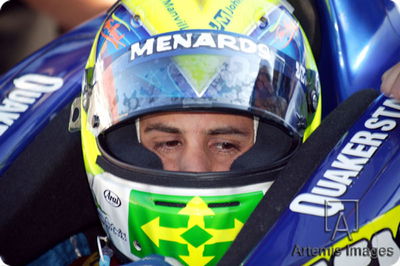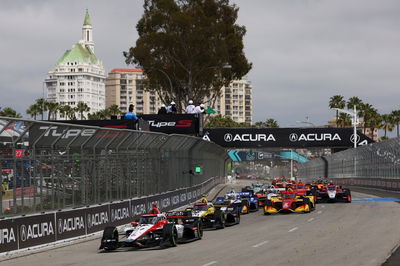Q&A: Vitor Meira.
Vitor Meira will make his 2004 season debuts at Twin Ring Motegi with Team Rahal next weekend, and hopes that his performance in the #17 Panoz/G-Force-Honda will be convincing enough to earn him a crack at the Indianapolis 500.
MC:
Vitor, how are you?
Vitor Meira:
I'm good, my friend.
Q:
You are making your IndyCar Series debut this year at the Indy Japan 300. Last year, you finished the season with a fourth-place finish, so you have momentum going into 2004. But has it driven you nuts not to be in a car in Miami and Phoenix?

Vitor Meira will make his 2004 season debuts at Twin Ring Motegi with Team Rahal next weekend, and hopes that his performance in the #17 Panoz/G-Force-Honda will be convincing enough to earn him a crack at the Indianapolis 500.
MC:
Vitor, how are you?
Vitor Meira:
I'm good, my friend.
Q:
You are making your IndyCar Series debut this year at the Indy Japan 300. Last year, you finished the season with a fourth-place finish, so you have momentum going into 2004. But has it driven you nuts not to be in a car in Miami and Phoenix?
VM:
Yes, as a driver, you want to be in the car always. Even if are you in the off-season or something, when you maybe see races on the TV or whatever, you always want to be in the seat. Team Rahal Honda gave me a great opportunity here to kind of fulfil my wish here. And they are a great team. We are hurrying up to finish the car to Japan and do the debut.
Q:
Can you talk about how your partnership and relationship with Team Rahal came about?
VM:
After I left Team Menard, I started to talk with a couple of people, and they were one of them. Then, after January, right after a little bit after December, they put Buddy [Rice] on the car and were due to substitute Kenny [Brack]. And I kept talking to [Bobby Rahal], and to Team Rahal, and just got kind of extending the relationship that we had. And it came one day that they were going to do two cars, a three-car team, and they just called me offering the ride. And that was about it. We were in touch, we knew each other a little, and they liked the work I did last year with Team Menard. And they gave me an opportunity. I hope I do as well as I want to.
Q:
Vitor, last year you were the last guy to qualify for the Indy 500, becoming one of -- and we did a little research here on our end -- but becoming one of 689 people who have actually qualified for that race. Can you talk about what that means to be a part of that elite club?
VM:
I'll be really honest, before racing there, only on test days and on the qualifying day, it was kind of a 'for sure it's more than a normal race', but it wasn't what I expected was going to be. Until the race day. When I arrived there on race day and I saw the crowd and, also even after the race when I saw the names on the board there, of who the drivers were. When you see and when you live the Indianapolis tradition year-by-year and month-by-month, people saying about the 500 every day and you were expecting also the next 500, it becomes bigger than you think it is. Because I didn't know about the 500 until I started to race. And it's people here in America and also mostly in Indianapolis, they grow and when they are two years old they already start to listen about the 500. And I didn't. So that's why I didn't think it was this big, but after the race, and even going to the race, I thought like, oh my God, this is the real deal.
Q:
Are you talking about the board in the Hall of Fame museum? Is that what you mean when you walk in and see all the names of the people?
VM:
Yeah, people that raced there already. So it's a gigantic energy there.
Q:
Vitor, you've driven a Dallara-Chevrolet for your entire IndyCar Series career, and now you're stepping into a Panoz/G-Force-Honda at Motegi. How do you prepare for that when you can't go testing?
VM:
Actually, the only way you can do it is analysing the data they have on the G-Force already. And the Honda. And talking to the drivers that drove both of them actually. Then you get to know the difference. And that's really the only way you can get prepared for it. I am going to be in - I won't say a tough situation, because the team is going to help me a lot, and they are really good - but I'm going to be in a really a difficult situation because it's going to be a new engine, which is the last thing that concerns me, but I'm going to be in the different car and different track that I have never seen.
And not driving the IndyCar Series car for three months more or less is going to make my life a little bit tougher, but I'm pretty sure that there's not going to be, we are not going to have any problems. It's just taking it easy, do what we know what to do, do what we know. And go from there. It's not, it's nothing really, really new. I guarantee that my first race in Indy cars was way tougher than this. So now, it's just pace myself a little bit and think before I do anything. And everything's going to be all right.
Q:
You've gotten a reputation of being able to jump into a car when you came in at the toward the end of last year and stepped into the car when someone else was driving it. I think you'll be fine, but I wonder, are you going in any earlier than you might ordinarily do or going in with everyone else?
VM:
Well, I'm going to be there on Sunday. I'll be there already. So I'm leaving here Saturday. I'll get used to the time change and I also want to have some, I mean, to absorb as much as I can from there. Even the track, the climate, everything. I mean even time changing and the hotel and the people. I want to make sure that I don't feel that we are on the other side of the world.
Q:
Is it a one-race deal with Team Rahal in Japan, or is there anything with Indianapolis or anything moving on this year?
VM:
So far, it's a monthly deal. We, they are going to decide after the month. They are the ones that are going to say if they want me here still to keep going or not. And this is going to depend on Kenny's recuperation, going to depend on my performance, going to depend on a bunch of stuff. But so far it's a monthly deal. So it gets to the end of April and suddenly let's say Kenny is okay to drive, yeah, they're going to put Kenny in the car. But they still can have the contract, they still may even if I'm not driving, they still can extend the contract. And that's how it is, it's a monthly deal.
Q:
Do you feel a little pressure to perform in Japan?
VM:
Even if I had the year contract or a five-year contract, I would feel pressure. Because I think the pressure comes more from you and how good you want to do. And I want to do good. And the pressure that comes, the worst pressure and the biggest for me, it's from, it's the pressure from myself. For sure there is pressure, but I mean it's pressure comes also with expectations. So I'm trying to be realistic about everything and not kind of not do anything, anything silly.
Q:
Vitor, tell us about what you did in the off-season? Did you go home to Brazil, spend time in Indianapolis?
VM:
I think I went to Brazil on the 15th of December, and there I stayed testing for quite a bit. I think I did ten days and tested a lot of prototypes. So I stayed in the car and stayed in shape. And also I spent some time with the family, and then I came here, I came back here in the beginning of January to Portland to Ted [Quackenbush]'s house, my manager. So we stayed together talking to people and talking to everybody, trying to find a ride. And finally it came along with everything with Team Rahal Honda.
Q:
Any marathons, mini-marathons, triathalons or anything like that?
VM:
No, I'm getting ready for it now. It's one-and-a-half years to, to the Ironman. So we'll see how it goes. I'm trying to fit it with racing and also just kind of getting prepared also to the Ironman, it's, I mean it doesn't allow you to do a lot of fun stuff afterwards.
MC:
I understand. Vitor, thanks for joining us today and we will see you next week down in Japan and in Indianapolis in May.
VM:
Okay. Thank you very much for the opportunity.










